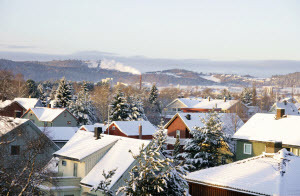Peak Winter Energy and Stack Heights - Air Mail!
The New York State Department of Environmental Conservation sent this bulletin on 01/22/2021 02:14 PM EST |
| DEC Delivers - Information to keep you connected and informed from the NYS Department of Environmental Conservation |
| Share or view as a web page || Update preferences or unsubscribe |
This Month's Topics |
Public & Stakeholder Participation Information
Additional information and access to past announcements are on our Public & Stakeholder Participation Information page. Air Mail! is the publication to announce public and stakeholder information about air quality topics. All NYS residents are environmental stakeholders – we welcome anyone to join the information sessions and other opportunities posted here. Cold Winter Weather Leads to Peak DemandWhile peak energy use is typically a summer problem, it is also an issue in the winter. Peak energy demand happens when everyone’s combined electricity use is higher than the amount the power grid can supply. In the winter, energy use peaks in the morning and evening when people turn on lights, turn up thermostats and use hot water. Peak energy demand might happen on a frigid day when home heating and hot water usage is up. Extra power plants would be brought online to make up for this added electric demand. These extra plants are often old, inefficient, and generate a lot of air pollution locally. The air pollution made by these so-called “peaker” plants negatively impacts the surrounding communities, which are often low-income or environmental justice areas. With nearly one-third of Americans using electric furnaces and heat pumps to heat their homes, it’s easy to see why peak demand is an issue in the winter. Energy demand will likely be compounded this winter because so many people are working and learning from home due to COVID-19. To lower your electricity cost and your contribution to air pollution, visit NYSERDA’s website for some winter-time energy saving tips. Air Pollution Control Basics – Stack HeightIn our September issue of Air Mail!, we discussed how Method 9 is used to observe smoke opacity from smokestacks and chimneys. It is also used to determine smoke density from various smoke sources, including exhaust pipes and even certain diesel-fueled vehicles, just to name a few. Chimneys and industrial smokestacks require proper construction and sizing to reduce the impacts of air pollution around homes and businesses. Smoke rising from stacks might include nonregulated emissions, such as water vapor, or regulated pollutants, such as nitrogen oxides, carbon monoxide, carbon dioxide, and particulate matter. Exposure to such pollutants may affect human health.
For your own home’s chimney or stovepipe, the National Fire Protection Association recommends that inspections be performed at least once a year. Regular inspections and cleaning help identify potential problems and mitigate them before they cause any threat to your family and nearby residents. The Chimney Safety Institute of America provides further information on taking care of your home chimney and fireplace for your safety. Homeowners can also check with their local governments for any ordinances specific to chimneys and stovepipes. Graphic Caption: The graphic shows the effects stack height has on downwash. The red lines indicate air flow trajectories around a building, and the gray shading estimates the wind’s effect on smoke plume. Downwash blows smoke and pollution towards the ground where it can concentrate and be breathed in by people and animals. Graphic Credit: Lakes Environmental Software Helpful Links
Dates to Remember
Stay Informed about Your Air QualityNYS' ozone season runs from April through September. DEC publishes ground-level ozone forecasts during ozone season and particulate matter pollution forecasts year-round using a scale called the Air Quality Index (AQI). DEC sends out an air quality alert when there is a high AQI value, which indicates polluted air. Individuals with pre-existing respiratory or cardiovascular conditions, and people who exercise outdoors should take caution during an air quality alert. Find out if an Air Quality Alert is in effect by calling the toll-free Ozone Hotline: 1-800-535-1345. The AQI can be accessed in three ways:
We would like to know what you think. Please send your Air Mail! questions or comments to us at DAR.web@dec.ny.gov. |



 The height of stacks should be tall enough for the smoke, or emissions, to rise high enough to efficiently disperse the pollutants over a wide area and minimize the effects of “building downwash,” which can occur if the stack height is insufficient. Downwash occurs when the wind blows stack emissions downward next to or between buildings, trapping the emissions close to the ground. While downwash can never be completely eliminated, the stack’s height should be tall enough so emissions are better able to escape this cavity region.
The height of stacks should be tall enough for the smoke, or emissions, to rise high enough to efficiently disperse the pollutants over a wide area and minimize the effects of “building downwash,” which can occur if the stack height is insufficient. Downwash occurs when the wind blows stack emissions downward next to or between buildings, trapping the emissions close to the ground. While downwash can never be completely eliminated, the stack’s height should be tall enough so emissions are better able to escape this cavity region.